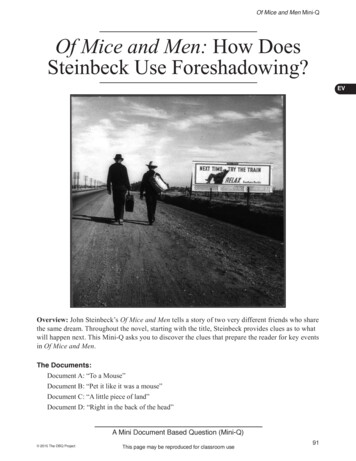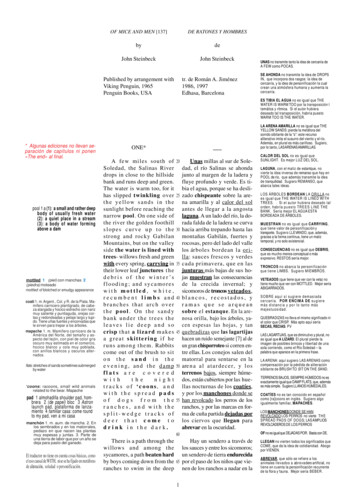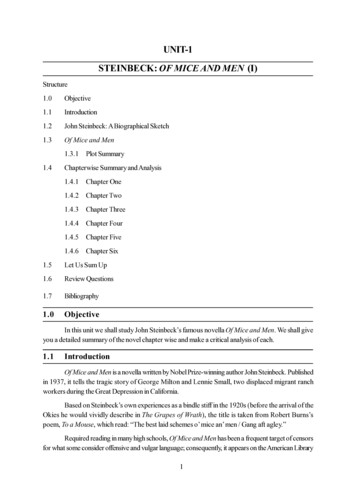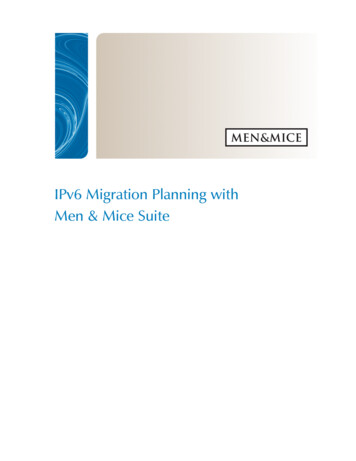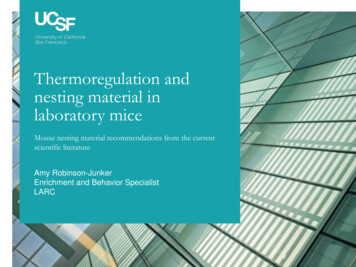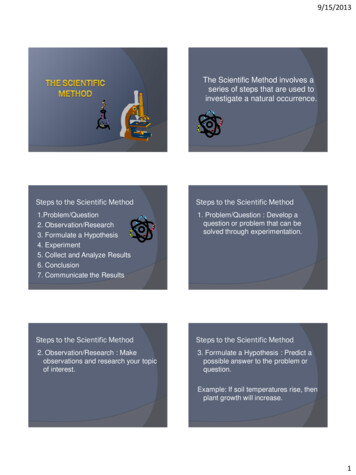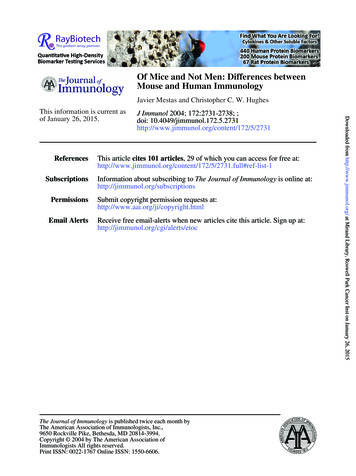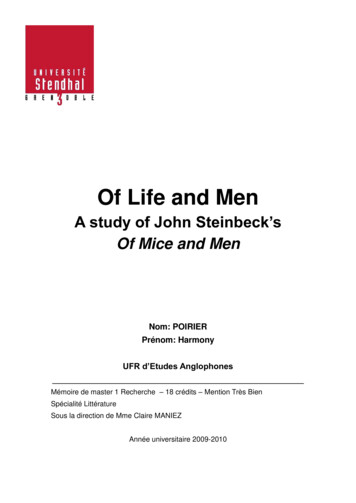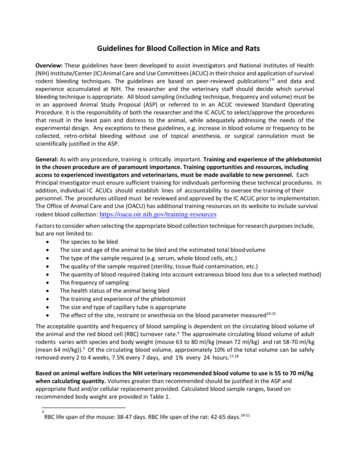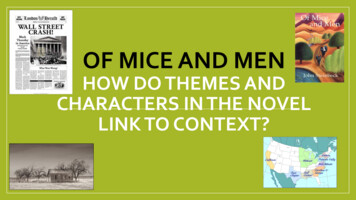
Transcription
OF MICE AND MENHOW DO THEMES ANDCHARACTERS IN THE NOVELLINK TO CONTEXT?
Lesson 1 - Learning ObjectivesWe are learning to understand what context is, and why it isimportant to have knowledge of the context ofa novel. understand the author’s background and hisreasons for writing Of Mice and Men. predict what the book might be about.
What is Context?Write a sentence giving your definition of the word context.Context dictionary definition:‘the circumstances that form the setting for an event, statement, or idea, and interms of which it can be fully understood.’Historical context:Circumstances that have taken place in history that have influenced events,statements or ideas.
Why is context important when studyinga novel?In order to fully understand a novel when studying literature, readers need to takeinto account historical and social context.By doing this, the reader will be aware of events and influences taking place at thetime that may have had an impact on the author’s writing. This impact may beshown through themes and ideas, characters, style of writing and plots.Becoming aware of this background information can help you to understand andappreciate the novel, and help you form your responses more effectively.
The Author - John SteinbeckMany of his books dealwith the lives andproblems of workingpeople.He wrote the book ‘ OfMice and Men’ in 1936, itwas published in 1937.Stick the cut outof John Steinbeckinto your booksand copy thenotes around him.Often men travelled alonelooking for work.He came fromSalinas, CaliforniaThe living conditions for thefarm workers were very poor.Steinbeck worked on a ranch when hewas 19, and used his experiences in‘Of Mice and Men’.Many of his characters in his booksare immigrants, who went toCalifornia looking for work or a betterlife.Of Mice and Men focused on theplights of poor migrant workerssearching for hope and the AmericanDream.
Why did Steinbeck write Of Mice andMen?Task – Taking into consideration what you have just learnt about Steinbeck,using only 3 sentences, write down why you think he wrote Of Mice and Men.Though Steinbeck came from a relatively well-off family, hehad much familiarity with the experiences of the migrantworkers in the region since he grew up there. As an adult, hetravelled through the small valleys to gain first handexperience from the workers. It doesn't appear that there wasone specific event that led to Of Mice and Men, but Steinbeckwas interested in the plight of the migrant worker, and, really,human suffering in general.Even better ifyou can use acomplexsentence!
Judging a book by its cover! Look at these front covers.1.Write a list or words that you would associate with the images displayed on thefront covers.2.Make a prediction about what the novel will be about.3.Justify your decision with examples from the front covers.
Timeline of events leading up to thepublication of the novel Of Mice and MenTurn your page landscape and draw this line across it.18501914The Author,JohnSteinbeck, isborn inSalinas,California.1902Period of mass immigrationinto the USA from abroad,especially from Europe.People came for manyreasons but in particular toescape poverty and/orpolitical oppression.America was seen as ‘thehome of the free’ and a landof opportunity where hardwork will bring success.Many dreamt of owning andfarming their own land.The First WorldWar: Americaentered the warin 1917 with over2 million mengoing to fight inEurope .19141918The on fromHoover.1929193319201931The roaringtwenties.War is over,Americansarecelebrating.Banks andfactoriesclose.Farmingcollapses.Of Miceand Menispublished.19371936Rooseveltimplements TheNew Deal –support forunemployment.
The American Dream At the end of the 1800’s there was a discovery of gold in California. This sparks amajor wave of migration from the east of the USA (and Europe) to California onthe west coast. People came for many reasons, but in particular to escape poverty and/or politicaloppression. America was seen as ‘the home of the free’ and a land of opportunitywhere hard work will bring success. Many dreamt of owning and farming theirown land. In the definition of the American Dream by James Truslow Adams in 1931,"life should be better and richer and fuller for everyone, with opportunityfor each according to ability or achievement" regardless of social class orcircumstances of birth. People ultimately believed that if you worked hard enough you wouldachieve success.
‘The Roaring Twenties’Watch the following clip. Create a mind map to describe how the people behaved inAmerica at this time.The Roaring Twentieshttps://www.youtube.com/watch?v IgcuBOVMGsg
‘The Roaring Twenties’Following WW1, for many people in America (especially the cities such as New York andChicago) the 1920s are years of considerable prosperity. American goods are protected fromcompetition with imports by high tariffs (customs duties) and Americans are encouraged tobuy American produced consumer products such as cars, washing machines, refrigeratorsand radios.It becomes much easier to borrow money to purchase goods, for example through the new‘hire-purchase’ schemes– getting the goods immediately but paying for them byinstallments. People also borrow money to buy shares in American companies.Americans were celebrating, feeling positive and spendingall their money!
The Wall Street Crash and The GreatDepressionIn 1930’s America, following The Wall StreetCrash, life was abysmal for many. There was massunemployment and poverty due to the Americanstock market collapsing. People lost their jobs,homes and life savings as banks and industriesclosed.
The Great DepressionWhen ‘Of Mice and Men’ was published in 1937 America wasin the grip of a huge economic depression. On October 29 1929,the Wall Street Crash led America into a depression whichcrippled the country from 1929 - 1936. When banks went bust,people lost their life savings and at one point one third ofAmerica's population were unemployed. Back in the 1930s therewas no welfare state to help the unemployed so food becamescarce and millions of jobless men and women lost their homesand were forced to live in shanty settlements known as'Hoovervilles.’ Their homes were constructed from corrugatediron and anything else the people could get their hands on.
The HoovervilleHooverville
Wall Street Crash, 1929A solemn crowd gathered outside the StockExchange after the Wall Street Crash of 1929.
Panic on the streetsof New YorkA crowd at New York's American Union Bankduring a bank run early in the Great Depression.
To make matters worse, a series of droughts instates like Kansas, Oklahoma and Texas led to thefailure of harvests and barren land. Farmers wereforced to leave their land as they couldn't repaytheir mortgages and had to sell what they had to payoff their debts.Economic migrants went west to California,believing there would be land and jobs, but manywere refused entry to the ‘Golden State’ and turnedback. The refugees had nowhere to go back to, sothey set up home in the California valleys - living inshacks of cardboard and old metal - and looked forwork as casual ranch hands. The farm hands werefortunate for at least a bunk-house to live in and tohave food provided, even though the pay was low.
The Dust BowlAway from the havoc of the cities, America’s rural areas were also suffering.A drought had been taking place for several years, resulting in ruined cropsand dried up soil. Farmers were driven off their farms because of a lack ofmoney.These droughts mainly affected the mid-West – Oklahoma and Arkansas –also known as the ‘Dust Bowl’.
The DustbowlBuried machinery in Dallas during the 1936 Dust Bowl, anagricultural, ecological, and economic disaster.
DestituteDestitute family in California. Mother of seven children, aged thirtytwo. In the 1930s, the American Government employed severalphotographers to document the effects of the Great Depression onthe population of America.
MigrationDue to the high rates of unemployment in the cities, and the drought in The DustBowl, during the 1930’s there were masses of migrants moving towards Californialooking for work. Many men travelled alone, with no home and barely anybelongings. The living conditions for these men were very poor. They movedfrom farm to farm, ranch to ranch, doing hard physical labour to earn moneyany way they could.A lot of these migrants clung on the American Dream, believing that if they workedhard enough they would be able to have their own land and build a future.
Prediction.Task:Taking into account the front covers you have seen, and the context we have nowstudied, using only 3 sentences write a second prediction what you think the novelwill be about.Your prediction will be even better if: You include evidence from the front covers to give reasons for your prediction. You link your prediction to the context we have discussed. You use a complex sentence.
Great Depression Mind MapThe WallStreetCrashDustbowlThe GreatDepressionpovertyCreate a mind map using what you have learned about The Great Depression.
Check Your UnderstandingCan you complete the following sentences?‘Of Mice and Men’ is set in Steinbeck wrote about On October 29th 1929 The Great Depression brought hardships such as The Dust Bowl was The American Dream is
Lesson 3 - Learning ObjectivesWe are Beginning to read Of Mice and Men. Considering the opening to the novel, and whattype of setting is created.
Read the opening tothe novel.Choose one word to describe thesetting.Now track through thedescription picking outquotations that help you answerthe following questions:1.2.What kind of setting iscreated?How is it created?
Students should read the rest of the noveltaking regular pit stops for the teacher todiscuss important events.
Lesson 4 - Learning ObjectivesWe are learning to understand how the American Dream isportrayed throughout the novel. answer a language style “How” question.
Read the following pages from the novel. Findquotes that show the characters believe in theAmerican Dream. Some have been done for you.Pages/CharactersQuotesGeorge and Lennie – page 32“Someday – we’re gonna get the jack together and we’re gonnahave a little house and a couple of acres an’ a cow and some pigsand ”Lennie – page 83“George, how long’s it gonna be till we get that little plan an’ liveon the fatta the lan’- an’ rabbits?”Candy – page 87“.I could cook and tend the chickens and hoe the garden some.”Lennie – page 101Crooks – page 109Curley’s wife – page 124Candy – page 132
Task – The American Dream.How does Steinbeck portray that characters in Of Miceand Men still have faith in the American Dream? [5]Use the quotes you have collected to form PEE chains.
Answering a ‘How’ QuestionWhen answering a ‘How doesthe writer.’ question, you arefocusing on language usedand the impact it has on itsreader.Consider:Why has the author hasincluded the words andphrases used?What do they show?How does this impact thereader?
PointEvidenceSteinbeck highlights that characters of the novel Of Mice and Men still have faith inthe American Dream as many characters make reference to their hopes for thefuture.Lennie states, “George, how long’s it gonna be till we get that little plan an’live on the fatta the lan’- an’ rabbits?”Explanation This highlights that Lennie is optimistic about the future and believestheywill be able to make a better life for themselves.In addition Furthermore Also Finally Create 4 more PEEchains using your tableof quotes.Remember to link yourpoints with theconnectives!Task:How doesSteinbeck portraythat characters stillhave faith in theAmerican Dream?[5]
Lesson 5 - Learning ObjectivesWe are learning to understand the context of racism, inequality and segregation in1930’s America. answer a language style ‘summary’ question.
Key wordsRacism: discrimination, or antagonism directed against someone of a different racebased on the belief that one's own race is superior.Superior: a belief that one individual, or a group of individuals, are better thananother. Therefore, deserves better opportunities and treatment.Inferior: a belief that one individual, or group of individuals, are not as worthy asanother. Therefore, they do not deserve equal opportunities and treatment.Inequality: the idea of being unequal or uneven. Individuals are who are not treatedequally.Segregation: the action or state of setting someone, or something, apart fromothers.
Racism in 1930’s America Following the American civil war, slavery was abolished. However, most white people stillbelieved that blacks were inferior in every way. Politically, socially, and economically, black Americans were second-class citizens. Theyhad to be kept in their place. For most white Americans, the question of equal rights forblack Americans simply did not arise. The 'negro' was inferior - that was just the way thingswere. In the years after World War I, there had been a major revival in the strength of the Ku KluxKlan, the most well known of the racist organisations. By the mid-1920s, the Klan had over 100,000 members across the South and had begun toextend its influence into Northern and Western states. Its campaigns of hate and violenceintensified and Klan violence, beatings, burnings, brandings, attacks with acid andlynching against black people increased rapidly. The result of this was inevitable. Blacks were intimidated and terrified by these frighteninglevels of violence, and were afraid to challenge white racism.
The Jim Crow LawsJim Crow laws were state and local laws that enforced racial segregation inthe Southern United States. Enacted by white politicians after slavery wasabolished, these laws continued to be enforced until 1965.These lawns meant that black people were segregated in many ways.
In pairs, consider howthese imagessymbolise the JimCrow laws.
Examples of Jim Crow Laws: A black male could not offer his hand (to shake hands) with a white male because it implied being sociallyequal. Obviously, a black male could not offer his hand or any other part of his body to a white woman,because he risked being accused of rape. Blacks and whites were not supposed to eat together. If they did eat together, whites were to be servedfirst, and some sort of partition was to be placed between them. Under no circumstance was a black male to offer to light the cigarette of a white female -- that gestureimplied intimacy. Blacks were not allowed to show public affection toward one another in public, especially kissing, becauseit offended whites. Jim Crow etiquette prescribed that blacks were introduced to whites, never whites to blacks. For example:"Mr. Peters (the white person), this is Charlie (the black person), that I spoke to you about." Whites did not use courtesy titles of respect when referring to blacks, for example, Mr., Mrs., Miss., Sir, orMa'am. Instead, blacks were called by their first names. Blacks had to use courtesy titles when referring towhites, and were not allowed to call them by their first names. If a black person rode in a car driven by a white person, the black person sat in the back seat, or the back ofa truck. White motorists had the right-of-way at all intersections.
Women’s Rights in 1930’s AmericaWomen in the first decades of the 20th century saw increased opportunity and publicpresence, from union organizing, to increasing availability of contraceptiveinformation, to winning the vote for women, to dress styles and life styles that weremore comfortable and less restrictive, to a greater sexual freedom.However, they were still seen as inferior to men. Women were able to gainemployment more easily, but these would be low skilled jobs with low wages.Women would also be paid less than men for the same role. Women were stillencouraged to be housewives whose main responsibilities were caring for theirchildren and home.
Task!Summarise how the Jim Crowlaws impacted black people inAmerica. [5]
Summarising
Always Remember!Top tip!
Jim Crow LawsOur Own WordsA black male could not offer his hand (to shake hands)with a white male because it implied being sociallyequal. Obviously, a black male could not offer his handor any other part of his body to a white woman, becausehe risked being accused of rape.Black people were not allowed to touch white people.They were seen as inferior to white people thereforecould not have physical contact with them. If a blackman touched a white woman, he may even be accusedof something sinister.Blacks and whites were not supposed to eat together. Ifthey did eat together, whites were to be served first, andsome sort of partition was to be placed between them.Black people were not allowed to eat with white people.They would have their own sections in restaurants. Also,white people would have their food first if they atetogether.Under no circumstance was a black male to offer to lightthe cigarette of a white female -- that gesture impliedintimacy.Blacks were not allowed to show public affection towardone another in public, especially kissing, because itoffended whites.Jim Crow etiquette prescribed that blacks wereintroduced to whites, never whites to blacks. Forexample: "Mr. Peters (the white person), this is Charlie(the black person), that I spoke to you about."
Summarise how the Jim Crow laws impacted blackpeople in America. [5]Firstly, black people were not allowed to touch white people. They were seen asinferior to white people therefore could not have physical contact with them. If ablack man touched a white woman, he may even be accused of something sinister.Also, In addition, Furthermore, As well as this, Finally,
Lesson 6 - Learning ObjectivesWe are learning to understand how the themes of racism, inequality and segregationare prevalent throughout the novel Of Mice and Men. create useful revision tools.
Racism and Inequality in Of Mice and MenThe theme of racism plays a powerful role in Of Mice and Men.Though a secondary character, Crooks exemplifies the very real and powerfulimpact of racism in California at this time.Whereas the white ranch hands live together in the bunkhouse, Crooks lives alone ina makeshift shed. This physical segregation reflects his own separateness from theother ranch workers and also mirrors the legal segregation so common in this era,particularly in the many Jim Crow laws in effect in the South, which impactedeverything from voting laws to the segregation of schools and other publicinstitutions.
ThinkPairShareWhy mightsomeone betreated asunequal?Whichcharacters in OfMice and Mendo you think aretreated asunequal?
Character Analysis:CharacterAnalysisCrooksTreated as inferior due to his race. He suffers racialdiscrimination through segregation.CandyLennieCurley’s wife
Find evidence from the novel that highlights howthese characters are treated as inferior/unequal.Curley’s wifeSome have been done for you.LenniePage 50Candy, aboutCurley’s wife, “Well, Ithink Curley’smarried a tart.”Page 54George, aboutCurley’s wife, “Don’tyou even take a lookat that bitch.”Page 51Page 67Racism/Inequality/Segregation in OfMice and MenPage 103CandyCrooksPage 45George to Candy,“You was poking’your big ears into ourbusiness.”Page 72“Candy looked forhelp from face toface.”Page 40Page 72Page 103
How are all these quotes similar? Can you spot atheme? "'A guy needs somebody-to be near him.' He whined, 'A guy goes nuts if he ain't gotnobody.” "Why can't I talk to you? I never get to talk to nobody. I get awful lonely." "Candy looked for help from face to face." "Cause I'm black. They play cards in there, but I can't play because I'm black.“ "Guys like us, that work on ranches, are the loneliest guys in the world. They got no family.They don't belong no place.With us it ain't like that. We got a future. We got somebody totalk to that gives a damn about us."
Lesson 7 - Learning ObjectivesWe are learning to understand how the theme of loneliness is prevalent throughoutthe novel Of Mice and Men. create useful revision tools.
Things to think aboutWhat does friendship mean to you?How would you feel if you didn’t have any friends?Can you think of any characters from the novel who may feel like this?
LonelinessCrooksGeorge and LennieCurley’s WifeCandyStick these characterson your A3 sheet.Together, we will beginto mind map howSteinbeck shows theyare lonely and isolated.Use the list of quotesto help you.
Lesson 8 - Learning ObjectivesWe are learning to
GCSE English Language: OF MICE AND MENExam Question:Explain how the language inthis extract captures the themeof loneliness.(10 marks)“Damn right he is,” said Carlson. “He don’t give nobody else a chance to win —” He stopped andsniffed the air, and still sniffing, looked down at the old dog. “God awmighty, that dog stinks. Gethimouta here, Candy! I don’t know nothing that stinks as bad as an old dog. You gotta get him out.”Candyrolled to the edge of his bunk. He reached over and patted the ancient dog, and he apologized, “Ibeen around him so much I never notice how he stinks.”“Well, I can’t stand him in here,” said Carlson. “That stink hangs around even after he’s gone.” Hewalked over with his heavy-legged stride and looked down at the dog. “Got no teeth,” he said. “He’sall stiff with rheumatism. He ain’t no good to you, Candy. An’ he ain’t no good to himself. Why’n’tyoushoot him, Candy?”The old man squirmed uncomfortably. “Well—hell! I had him so long. Had him since he was a pup. Iherded sheep with him.” He said proudly, “You wouldn’t think it to look at him now, but he was thebest damn sheep dog I ever seen.”George said, “I seen a guy in Weed that had an Airedale could herd sheep. Learned it from the otherdogs.”Carlson was not to be put off. “Look, Candy. This ol’ dog jus’ suffers hisself all the time. If you was totake him out and shoot him right in the back of the head—” he leaned over and pointed, “—rightthere, why he’d never know what hit him.”Candy looked about unhappily. “No,” he said softly. “No, I couldn’t do that. I had ‘im too long.”“He don’t have no fun,” Carlson insisted. “And he stinks to beat hell. Tell you what. I’ll shoot him foryou. Then it won’t be you that does it.”Candy threw his legs off his bunk. He scratched the white stubble whiskers on his cheek nervously.“I’m so used to him,” he said softly. “I had him from a pup.”“Well, you ain’t bein’ kind to him keepin’ him alive,” said Carlson. “Look, Slim’s bitch got a litter rightnow. I bet Slim would give you one of them pups to raise up, wouldn’t you, Slim?”The skinner had been studying the old dog with his calm eyes. “Yeah,” he said. “You can have a pupifyou want to.” He seemed to shake himself free for speech. “Carl’s right, Candy. That dog ain’t nogoodto himself. I wisht somebody’d shoot me if I get old an’ a cripple.”Candy looked helplessly at him, for Slim’s opinions were law. “Maybe it’d hurt him,” he suggested. “Idon’t mind takin’ care of him.”Carlson said, “The way I’d shoot him, he wouldn’t feel nothing. I’d put the gun right there.” Hepointedwith his toe. “Right back of the head. He wouldn’t even quiver.” Candy looked for help from face toface.
Of Mice and Men focused on the plights of poor migrant workers searching for hope and the American Dream. Steinbeck worked on a ranch when he was 19, and used his experiences in 'Of Mice and Men'. Many of his characters in his books are immigrants, who went to California looking for work or a better life. The living conditions for the
